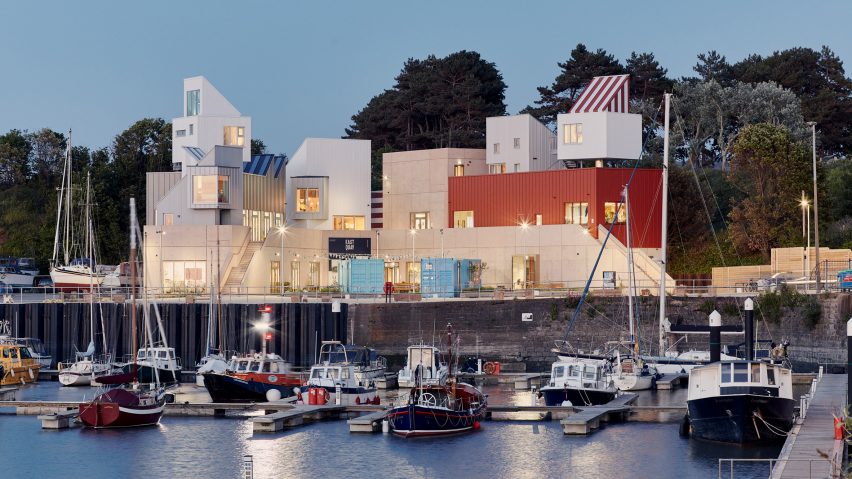UK studios Pearce+ and Fægen have designed the interiors of five sleeping pods that stand on top of the Invisible Studio-designed arts centre on the dockside in Watchet, UK.
The studios aimed to design the pods, which were created to provide interesting accommodation for people visiting East Quay and the town, to align with the ethos of the arts centre.
"The whole of East Quay is about culture, purpose and imagination – it is a hub of creativity, opportunity, artistry and ideas," explained Pearce+ founder Owen Pearce.
"It is also most importantly about community – multiple hands and many eyes," he told Dezeen.
"We wanted this to be captured in the pods also, providing inspiring, exciting, different, unusual spaces and involving as many hands as possible in the design, from artists to makers to kids."
The five pods are located in a series of metal-clad boxes on top of the East Quay arts centre, which was designed by Bath-based Invisible Studio with Ellis Williams Architects acting as executive architect for the local social enterprise Onion Collective.
Two of the pods stand on stilts above the building.
"All the pods are linked to their surroundings by fantastic views of the Bristol Channel, the Quantocks, the marina and the town," said Pearce.
"The form of the buildings feels rooted in the area as they jut and protrude as if continuously added to like some of the old houses in the town."
Each of the five pods is designed by Pearce+ and Fægen to have a different character and involve local artists and the community.
The first sleeping pod, which was built with reclaimed furniture and materials, was designed as a "living museum" where guests are encouraged to leave an item and take one away.
Etched illustrations cover the walls of pod two, which is designed by artist Isabelle Mollé and aims to tell the story of the town.
"Our overarching aim was to provide a connection between guests and the local community," explained Pearce.
"This is done, for example, through direct object transfer in pod one as guests donate objects of meaning and take something in return or, in pod two, by visually exploring the stories and myths of the town in CNC etchings on the walls."
The third pod aims to evoke the feeling of a 1920s ocean liner, while pod four "is about play" and has semaphore signals painted on the walls. Here there is also a cargo net for sitting, which is reached by a staircase hung from the ceiling.
Bristol graffiti artist Andy Council worked with local schoolchildren to create the interior of the fifth pod, which will be redecorated each year by an artist chosen by the Onion Collective.
In line with the ethos of the project, Pearce+ and Fægen moved to Watchet for a year to act as contractor and fabricate the interiors of the pods with the help of a small team.
Pearce hopes that the pods will provide fun places for visitors to stay and bring income into the community.
"The brief for the competition was quirky places to stay," he explained. "The client wanted to have fun with the pods and to provide an opportunity for inventiveness from architects."
"The building's aim is to support a local artistic community and provide opportunities that weren't available before. A key part of the economic strategy of the building is to attract guests from afar to bring in much-needed income, which in turn supports cultural and education work," he continued. "The designs are then targeted to create a cool place to visit in order to do that."
Pearce+ previously collaborated with UK studio Hugh Broughton Architects and artists Ella Good and Nicki Kent to create the inflatable Martian House, which is currently installed in Bristol.
The photography is by Joseph Horton.

